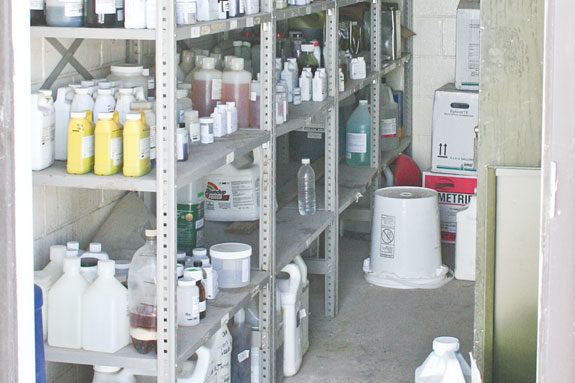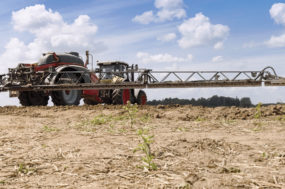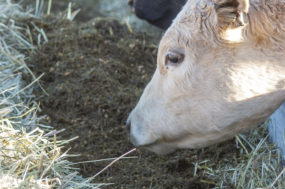How and where you handle pesticides and the supplies you have on hand may ensure your own safety and greatly reduce the risk of pesticide contamination.
Pesticide mixing
Do not mix or transfer pesticide near a well or water source. When possible, mix in the field at various locations; small quantities of pesticide spilled over a period of time in one area may accumulate and potentially cause a contamination.
If filling from a water system, either leave an air gap between the hose and the tank or use a backflow prevention device. Do not put the filler hose into the pesticide mixture.
If the water system allows draining, the above measures will prevent the pesticide from siphoning out of the tank.
Consider using a portable water supply tank; this will enable mixing in the field and, potentially, shorten pesticide tank refill times. Whatever system you use, do not leave a pesticide tank unattended when filling.
If you are purchasing new pesticide-handling equipment, consider either a closed handling or direct injection system. These may minimize pesticide exposure and reduce the potential for major spills.
Pesticides may also be available either as dry formulations or in pre-measured packets. Using dry formulations may reduce dermal (skin) exposure.
In addition, spills of dry products may be less problematic when it comes to containment and cleanup. However, take care to protect against inhaling the dust that may be found in some products.
Equipment inspection and repair
Set up a mental inspection list of sprayer equipment. The frequency of inspections depends upon individual preference and equipment demands. A quick daily inspection is recommended.
Check sprayer equipment hoses, fittings, valves and tanks for leaks or signs of failure.
Keep a supply of “critical” parts (parts that commonly fail) on hand and readily available in the event a leak develops. And to reduce your exposure to pesticide residues, always wear proper protective clothing when repairing sprayer equipment.
Rinsing application equipment and pesticide containers
Rinse pesticide residues from application equipment before both storage and extensive repair. Rinse equipment at different locations in the field (over a labeled site).
When handling pesticide containers of liquid products, triple or pressure rinse at the mixing site before disposal or recycling.
Do this as soon as possible after emptying the container. Add rinse water (rinsate) to the sprayer tank and either spray it out over a labeled site or use it to mix the next load.
Handling pesticide spills
Evaluate pesticide storage and transportation methods. To help contain leaks or spills, store pesticides in a locked storage area with an impervious floor (such as concrete).
Locate this area away from other activity and use it only for pesticide storage. Locking the storage area will reduce both the risk to children and the potential for the theft or misuse of the products.
Keep a current inventory of pesticides in storage and use the oldest products first. Keeping an inventory will not only help keep products from going out of condition; it may also be invaluable during emergency situations such as managing a fire or cleaning up after a natural disaster.
For the cleanup of pesticide spills in storage areas, keep absorbent materials such as cat litter or sawdust on hand.
When transporting pesticides, have a shovel available; the shovel can be used to form a dike to contain spills and keep them from running into drainage areas.
Have plastic sheeting and heavy bags on hand to hold pesticide and contaminated materials during cleanup.
Consider putting together a “spill response kit,” and keep it handy. This kit should contain such items as the following:
• duct or electrician’s tape
• washer-headed screws
• caulking or sealant
• absorbent materials
• extra hoses
• hose clamps
• plastic tarps or bags
• shovel
Have several empty drums or other containers available in case a sprayer tank needs to be drained.
When a spill occurs, follow this procedure:
1. First, put on appropriate protective clothing.
2. Stop or sufficiently slow the leak (to allow it to be contained).
3. Use absorbent material to soak up the spill, or dike with dirt to stop spill from moving away from the spill area.
4. As soon as possible after the spill is contained, contact at least one of the following: your state department of agriculture or department of environment and natural resources.
The above procedure will not only meet spill reporting requirements, these agencies will also provide technical assistance in cleaning up the spill.
If there is a question as to whether the spill is large enough to report, report it anyway – it is better to report a spill than ignore it and find that it should have been reported.
If the spill is not within a pesticide containment area (mixing/loading pad), contaminated soil generally will need to be removed and, depending upon the quantity, stored for testing and later disposal.
For small spills, shoveling the contaminated material into heavy plastic bags may be sufficient. For large spills, a loader or backhoe may be needed for moving contaminated dirt.
Know where such equipment is readily available. The sooner a spill is cleaned up, the less soil may need to be removed.
Pesticide handling and discharge response plan
All certified pesticide applicators are required to have a written plan, appropriate for their individual operation(s), outlining proper pesticide-handling and spill-response procedures.
The plans are to be kept current and available for inspection. Review the plan at least annually and provide new employees with training on the details of the plan within three days after beginning pesticide-handling tasks.
Include the following information in the plan:
• methods and procedures for properly handling pesticides, pesticide containers and application equipment
• methods and procedures for the inspection and repair of the equipment used for pesticide handling, application and storage
• methods and procedures for rinsing/washing pesticide containers and storage, application and transportation equipment
• methods and procedures to be used to contain, recover, handle and dispose of pesticide spills that have occurred either outside or inside a pesticide containment area (if required)
• emergency phone numbers to be contacted if a pesticide spill occurs. FG
References omitted due to space but are available upon request.
—Excerpts from South Dakota Extension website
PHOTO
TOP RIGHT: When handling pesticide containers of liquid products, triple or pressure rinse at the mixing site before disposal or recycling. Do this as soon as possible after emptying the container. Photo by FG staff.

Jim Wilson
Extension Educator
South Dakota State









